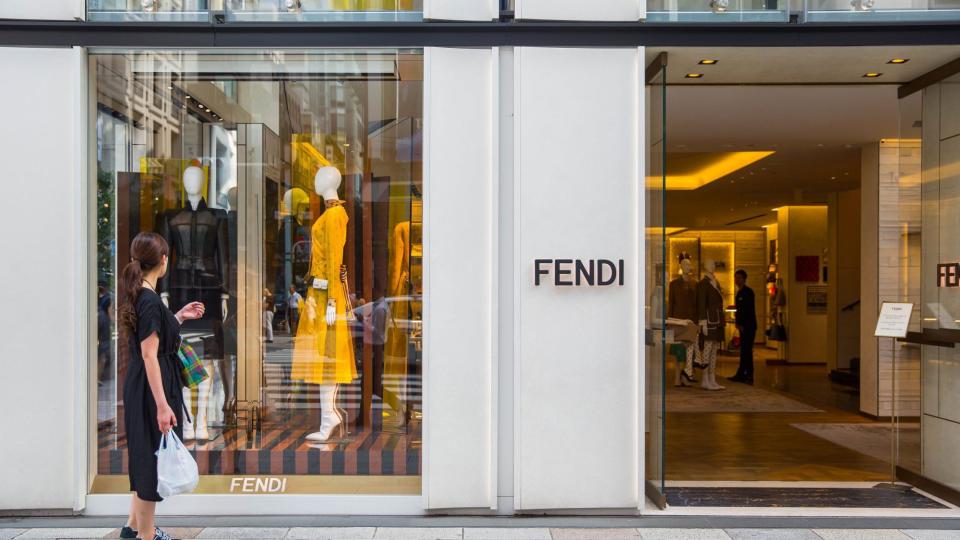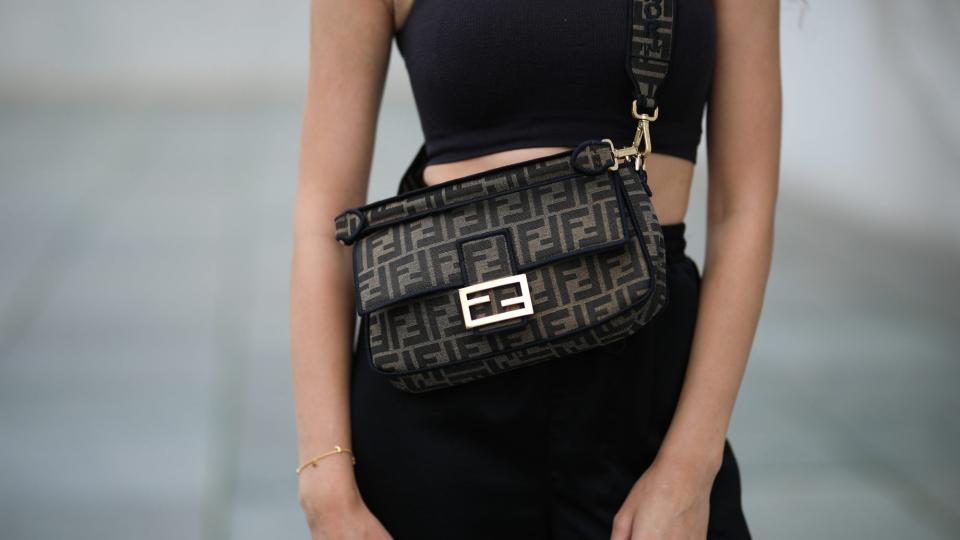Everything You've Ever Wanted to Know About Fendi's Fascinating History

Jacopo Raule/Getty Images
Fendi is a fashion label that is synonymous with luxury. The Italian brand is known for its daring handbags that are made with impeccable precision, not to mention its signature double "F" logo. For almost 100 years, the fashion house has been pushing forward toward innovation — all while keeping the collections inspiring and accessible.
Still run by the Fendi family, the brand is the same one that saw a young Karl Lagerfeld flourish as artistic director, which brought Fendi to the masses and showed customers how stunning and different certain materials can be. Let's rewind and go all the way back to the beginning in 1925 to uncover Fendi's rich Italian history.
RELATED: Kim Kardashian Is Not Proud of Her Infamous 2006 Fendi Outfit

Stanislav Kogiku/SOPA Images/LightRocket via Getty Images
How and Where Fendi Began
Adele and Edoardo Fendi created the fashion house in Rome in 1925. From its inception, Fendi has been known for its luxury and opulence. The brand began by making leather goods, which they're still famous for today. A family business from the beginning, with Adele and Edoardo's five daughters heavily involved with everything from coming up with fresh new ideas to helping sell the designer goods to excited customers looking for elegant pieces to add to their collections.
When Edoardo died in 1946, Adele and her daughters carried on with the business, never wavering as a fashion house focused on innovation and beauty.
The Introduction of Karl Lagerfeld
In 1965, Fendi welcomed Karl Lagerfeld to the brand. It was during Lagerfeld's tenure as creative director that the signature double "F" motif was created — which actually stands for Fun Furs, according to LVMH's brand book — and that idea came from Lagerfeld himself. While these days, many fashion houses, as well as InStyle, do not support the sale of fur, it was a hot commodity at the time. Lagerfeld pushed the brand forward into the fur market, making Fendi one of the most sought-after ateliers for fur goods. Rather than keeping fur simply for fur coats, Lagerfeld opted to use it for accessories, ready-to-wear designs, and anywhere else he could think of, making it more accessible to the brand's average customer, and giving fur a whole new way of existing.
RELATED: Gucci's History Is Just As Wild As Some of Its Designs

Vittoriano Rastelli/Corbis via Getty Images
Lagerfeld also worked closely with the Fendi daughters — who were still heavily involved and influential in the Fendi brand at this point — to continue to innovate the brand's offerings. The designs became even more creative, and they began to incorporate a lot of color, making Fendi pieces more unique and desirable. While fur had previously been a high-brow purchase, saved for the truly elite, the creative minds at Fendi were able to take 'lower-quality' furs and rework them into something their customers wanted to buy, which allowed them to keep the prices more accessible.
Lagerfeld was also responsible for launching Fendi's ready-to-wear collection in 1977, as well as a line of shoes in 1978. It was also in the 1970s that Fendi rolled out various artisan collections to continuously expand the brand, always keeping the leather goods and furs at the forefront.
The Evolution of the Brand
Adele Fendi died in 1978, and with that came a shake-up of the brand. Each of her five daughters took over a piece of the fashion house, with Lagerfeld still at the creative helm. The brand continued to evolve and stay at the forefront of luxury fashion, constantly innovating but still staying true to its Italian roots.
The 1980s was game-changing for Fendi — it was the decade that saw the brand explode into boutiques all over the world. The fashion house designed uniforms for the Rome police department and rolled out men's and women's fragrances. The first U.S. store popped up on Fifth Avenue in New York City in the late 1980s and the third generation of Fendi women started playing their role in the family business. These women helped create new pieces and further expand the business.
The Fendi Baguette
Perhaps the most well-known of all of Fendi's creations is the Fendi Baguette. The bag, created in the 1990s by Silvia Venturini Fendi, started a revolution in handbags for the fashion house. A-list celebrities snatched the bags up as fast as possible, including Madonna, Naomi Campbell, and others. The simple, chic bag came in a variety of options and inspired more iconic Fendi creations that followed in subsequent years. The Baguette is still one of the brand's most beloved bags, and one of the most commonly purchased items from the entire design portfolio.

Jeremy Moeller/Getty Images
The LVMH Takeover
In 1999, LVMH Moet-Hennesy and Prada struck a deal to acquire Fendi, according to The New York Times, putting LVMH's chairman Bernard Arnault and Prada chairman Patrizio Bertelli in charge. However, despite the sale, management of the Fendi brand remained with the third-generation Fendi sisters. At the time, Arnault told The New York Times, "Fendi today is maybe like Gucci or Prada five years ago; we want to give this name the full potential. It is a very, very hot brand."
The Introduction of Kim Jones
Fendi continued its rise through the years, always keeping the Fendi family in control and always staying authentically Italian. The Fendi women each had a piece of control of the brand, with all of them keeping the brand's roots tied to the family and to Italy. Silvia Venturini Fendi, Adele and Edoardo's granddaughter, was the one to eventually take over artistic direction of the accessories line (prompting her creation of the Baguette) and the menswear line. In 2020, though, Kim Jones joined Fendi as the artistic director of haute couture, ready-to-wear, and fur collections for women.

David M. Benett/Dave Benett/Getty Images for HUGO BOSS
RELATED: Ok, What's the Deal With This Fendi Dress?
Jones is working in conjunction with the Fendi family, particularly Sylvia, who is still at the center of the brand, according to WWD. He also remains at Dior Men's at the same time. Fendi's women's collections are actually his first foray into womenswear. Jones is the first person outside the Fendi family to join the brand in a prominent role since Lagerfeld, to whom the Fendi family paid tribute in 2019 after his death in their fall couture show in Rome. Not only did the fashion house pay tribute to their roots in Rome, but the entire show was dedicated to Lagerfeld and his legacy with the Italian brand, according to The New York Times.
The collection featured the values Lagerfeld brought to the brand, including lightness and a sense of identity. "Karl used to say 'Fendi is my Roman side,'" Silvia told The New York Times before the show. "It is impossible to do a show in such a place without paying homage to the setting and the city...we decided we had to do it, and dedicate this show to him. It was a way of showing we are a good, tight team and have learned so much from him."

Yanshan Zhang/Getty Images
The collection included 54 looks, one for each year Lagerfeld was with the brand and invoked the kind of magic he brought while artistic director. It was the perfect way to thank him for all he did for Fendi while continuing to move the brand forward into the future.
The Future of Fendi
Like many other fashion houses, Fendi has goals to be even more sustainable, using recycled materials and aiming to create less waste. However, unlike Prada, which has vowed to go fur-free, Fendi does not plan to stop using it as a material.
In an interview with WWD, the head of image, communications, and environment at LVMH Moët Hennessy Louis Vuitton, Antoine Arnault, discussed the topic a bit further.
"It is very important to tell the truth and this is a sensitive topic," he said. "Of course, we'll do everything we need to do to be even more compliant to the [already] highest standards of certification. However, we should not be naïve. It's not that if a group like ours stops making fur people will stop to buy fur and I much prefer to sell fur to those clients but fur done in the right way. I won't lie, yes, [the animals] die, but they are treated with the respect and humanity they deserve, and with the standards that we put in this work — it cannot be done better. I'd rather be the bad guy and to sell it to the customers when done the right way than to let others do it in horrible conditions and do their business like that. I know it's a difficult statement to hear but I am ready to take the consequences."
Only time will tell if Fendi's stance on the matter will change.

 Yahoo Finance
Yahoo Finance